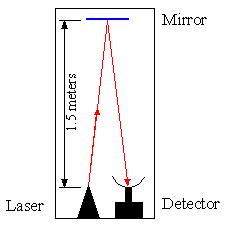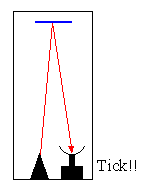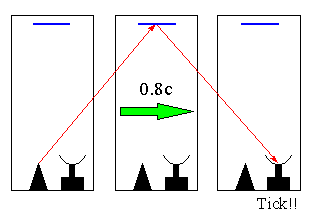

|
Astronomy 162:
Introduction to Stars, Galaxies, & the Universe
Prof. Richard Pogge, MTWThF 9:30
|
Lecture 31: A Tale of Two World Views:
Special Relativity
Readings: Chapter 24, section 24-1
- "Common sense is the collection of prejudices acquired
by age eighteen."
Albert Einstein (1952)
- "It will seem difficult at first, but everything is difficult
at first."
Miyamoto Musashi [Book of Five Rings 1645]
- Central Postulates of Relativity:
- The laws of physics are the same for all uniformly
moving observers.
- The speed of light is the same for all observers.
- Consequences:
- Different observers measure different times, lengths,
and masses.
- Only spacetime is observer independent.
Newton's Universe
In Newton's view:
- The universe keeps absolute time.
- Objects move through absolute space.
- Universe looks the same to all observers, regardless of how
they move through it.
The result was a set of laws formulated from the perspective of an
absolute "God's Eye View" of the Universe.
Einstein's Challenge
1905: Albert Einstein challenged Newton:
- We cannot take a "God's eye view" of the Universe.
- We can only compare our view with that of other observers.
- All information we have is carried by light.
- But, light moves at a finite speed.
Result is an irreducible relativity of our physical perspective.
Seeing the World
All information about the Universe is carried by light.
Speed of Light: c = 300,000 km/sec
Compared to everyday scales:
- 65 mph = 0.028 km/sec = 9.3x10-8 c
- light travel time in the lecture hall (front-to-back) = ~30 nanoseconds
- Human Reflex Time = ~0.1 sec (~108 nanoseconds)
Our everyday experience of the world is with phenomena at speeds
much slower than the speed of light.
1st Postulate of Relativity
The laws of physics are the same for all uniformly moving
observers.
"Uniformly" = "with a constant velocity"
Implications:
- No such thing as "absolute rest".
- Any uniformly moving observer can consider themselves to be
"at rest".
2nd Postulate of Relativity
The speed of light in a vacuum is the same for all observers,
regardless of their motion relative to the source.
Implications:
- The speed of light is a Universal Constant.
- We cannot send or receive information faster than the speed
of light.
This has been experimentally verified in all cases.
Essential Relativity
Two observers moving relative to each other experience the world
differently:
- Both measure the same speed of light
- Both find the same physical laws relating distance,
time, mass, etc.
- But, both measure different distances, times, masses,
etc. applying those laws.
The key is the role of light.
The Relativity of Time: A Thought Experiment
Consider a simple photon clock:

- Laser fires to a mirror 1.5 meters away
- Light bounces to a detector
- Photon Path Length = 3 meters
- One "Tick" = Time of Flight = 3 meters / c = 10-8
seconds
Relativity with Dick & Jane
Dick & Jane fly past each other in rockets:
- Constant Relative Speed = 0.8 c
- Jane is carrying a photon clock
- Each measures how long it takes between "ticks"
of Jane's photon clock.
What do they see?
- Jane's clock as seen by Jane:

- Jane's clock as seen by Dick:

He Said, She Said...
Jane's Observations:
- Jane's Speed = 0
- Dick's Speed = 0.8c
- Photon Speed = c
- Path Length = 3 m
- 1 Tick = 10-8 sec
- Jane says: "My Clock is running correctly"
Dick's Observations:
- Jane's Speed = 0.8c
- Dick's Speed = 0
- Photon Speed = c
- Path Length = 5 m
- 1 Tick = 1.67x10-8 sec
- Dick says: "Your Clock is running slow."
Relative Time
Our result is true for all clocks.
Conclusion: There is no absolute time.
- Times passes at different rates for observers moving relative
to each other.
- At speeds small compared to c, the difference is very small.
This has been verified experimentally using atomic clocks on airplanes
and satellites.
Consequences of Relativity
Observers moving relative to each other:
- Do not measure the same times.
- Disagree on what events occur simultaneously.
- Do not measure the same lengths of objects.
- Do not measure the same masses for objects.
Other Consequences:
- Mass and Energy are equivalent: E=mc2
- Massless particles must move at speed = c.
Spacetime
Newton's View:
- Space & Time are separate and absolute.
- Universe looks the same to all observers.
Einstein's View:
- Space & Time are relative.
- United by light into Spacetime.
- Only spacetime has an absolute reality independent of the
observer.
Light the Unifier
Because all information is carried by light at a finite speed,
to satisfy the requirements of the basic postulates of Special
Relativity:
- All uniformly moving observers see the same physical laws.
- All observers measure the same speed of light.
We must unify otherwise disparate ideas:
- Space and Time are unified into Spacetime.
- Matter and Energy are Equivalent (E=mc2)
What about Gravity?
Special Relativity is restricted to uniformly moving (unaccelerated)
observers.
But, objects are accelerated by gravity. (Newton: "They
feel a gravitational force.")
Einstein took 8 years to generalize relativity.
This effort was to lead to the formulation of a completely new
theory of gravity.
A Final Thought:
from Spacetime Physics, p. 5, by Edwin Taylor & John
Archibald Wheeler, W.H. Freeman and Company, San Francisco, 1966
edition.
- "The principles of special relativity are remarkably simple. They are
very much simpler than the axioms of Euclid or the principles of
operating an automobile. Yet both Euclid and the automobile have been
mastered - perhaps with insufficient surprize - by generations of
ordinary people. Some of the best minds of the twentieth century
struggled with the concepts of relativity, not because nature is
obscure, but simply because man finds it difficult to outgrow
established ways of looking at nature. For us the battle has already
been won. The concepts of relativity can now be expressed simply enough
to make it easy to think correctly - thus "making the bad difficult and
the good easy."[*] The problem of understanding relativity is
no longer one of learning but one of intuition - a
practiced way of seeing. When seen with this intuition, a remarkable
number of otherwise incomprehensible experimental results are revealed
to be perfectly natural."
[*] Quote is from Einstein, in a similar connection, in a letter to the
architect Le Corbusier.
Return to [
Unit 5 Index
|
Astronomy 162 Main Page
]
Updated: 2006 February 18
Copyright © Richard W. Pogge, All Rights Reserved.




